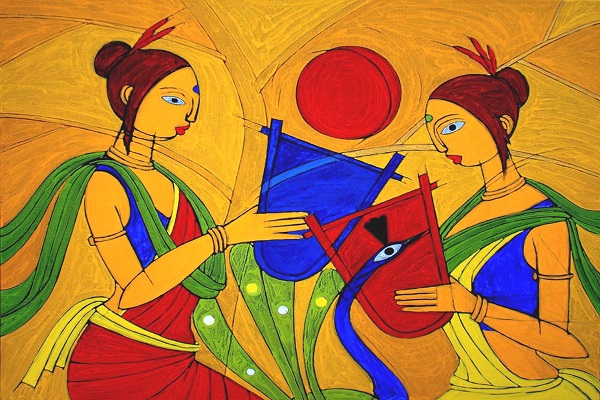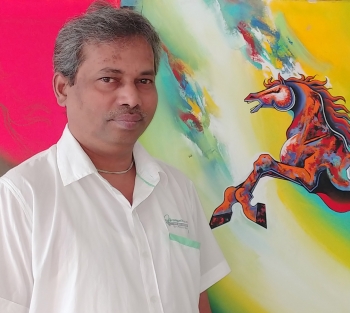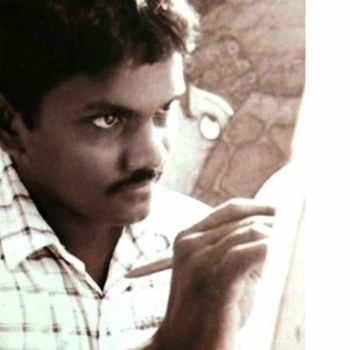
When it comes to innately bringing up creativity, arguably no medium is more eloquent than art. Artists and their art are endless and global phenomena due to the abundance of imagery, the evocation of every detail, and a repertoire of senses. India has produced a number of doyens in their fields and the minds behind some very brilliant works of art. Here are a dozen of the most famous Indian art paintings by legendary artists that have remained timeless masterpieces through the ages-
Bharat Mata by Abanindranath Tagore
Abanindranath Tagore's Bharat Mata is one of India's most famous paintings, with a muse so iconic that the connected work of art quickly became the face of a complete ideal. When it comes to the identity of the painting and the idea it represents, there is obviously no deception. Tagore's depiction of India during the period when she was under British rule and awaiting 'emancipation,' in the form of a saffron-clad woman holding a book, some paddy, a piece of clothes, and a rosary, much like a sadhvi, is the crux of this masterwork that became the very symbol of Swadesi.
Interestingly, this deeply moving work of art inspires the Goddess in women, drawing parallels to Bharat Mata, and thus serves not only as a patriotic tribute to the nation but also as a role model for everyone. The painting is a significantly more symbolic rendering of the India of our aspirations, despite its presumably human depiction.
The image conjured up by the Indian artists is of a multi-armed Goddess whose every movement is symbolic. Thus, the paddy represents the essential of nourishment, the piece of fabric represents vastra, the book represents the importance of education, and the rosary represents the beads of salvation—a vision of a free and independent Bharat capable of caring for all of its residents as Mata or mother. Tagore created a masterpiece in presenting a highly hopeful image of a free-spirited India, and it was responsible for the country gaining newfound respect, both as a Goddess and most importantly as the motherland.
The Indian Art Paintings of Horses By MF Hussain
Maqbool Fida Hussain, one of India's most prolific painters, is a name that conjures up images of unparalleled brilliance in the world of art. Hussain dedicated allegiance to many of his constant inspirations, who appeared in most of his works of art, and was as inventive and brilliant as someone with only his facultive abilities could be. Horses is a tremendously powerful work that focuses around Hussain's preoccupation with the containment of strength and energy by these swiftly nimble creatures. It is one of the most famous paintings of this fantastic painter, albeit of all India.
This classic painting by Hussain, which bought an astonishing over a crore of rupees at Christie's in 2008, captures the canvas with bold contours and enormous magnificence. The galloping boasts' energy is immediately noticeable, as is Hussain's preoccupation with their unfettered spirit and force.
Self- Portrait By Amrita Sher-Gil
Amrita Sher Gill, dubbed "India's Frida Kahlo," painted a self-portrait in 1931 that has long been regarded as one of the most famous paintings in India and is easily one of the finest manifestations of the artist's remarkable talent with colours and brushes. This image, which is quite popular among India's contemporary painters, is a glimpse into the mind of an 18-year-old Amrita, in which the seemingly half-smiling lady gazes with such intensity that the viewer is immediately aware of the melancholy that shrouds her inner self. All of the artist's incredibly popular self portraits show her in a variety of moods, ranging from joyful and playful to sad and forlorn, or even a hypnotic mix of both.
Three Pujarins By Jamini Roy
Jamini Roy, an acclaimed Bengali artist and one of India's early modernists, was a painter without peer when it came to executing his various ideas, which were as diverse as they were similar. Roy began painting works that are essentially representations of the Indian spirit as a deserving apprentice of Abanindranath Tagore, another remarkable master of the art and the founder of the Bengal School of Art. In truth, Roy's credit and that of his tremendous creative faculties is that, despite his training in western genres of art, he opted to live in his intrinsic Indianess when it came to creating his most memorable works.
Three Pujarins, for example, is a well-known artwork that captures the essence of India in every stroke. Inspired by Bengali folk art, the maestro's creation retains the brilliant hues that characterised most of his work, even though the hued reach remained limited. Three Pujarins is a representation of three almond-eyed priestesses in a worshipping avatar, mature and poised despite the piece's metaphorical overtones.
Shakuntala By Raja Ravi Verma
Shakuntala is known to be a very famous Indian Paintgings. It is an oil on canvas at piece which is very much known to be the embodiment of the loos love midst Shakuntala and Dushyant Saga. Shakuntala, while pretending to remove a thorn from her foot, is actually stealing a peek of her lover prince Dushyant in a display of youthful exuberance of and in love. Of course, there's nothing suggestive going on here; this is one masterpiece that asserts supreme identity for being exactly the beauty that it is, delivering by mannerisms and grace rather than symbolism and devoid of any figurative representation.
Shakuntala is a masterpiece in the way Verma oozes the very essence of the universal sensation of love. It is one of the few great paintings and painters that manage to make an indelible mark on the psyche with sheer play and no symbolism. Every lover would empathise with the charming deception that a young Shakuntala indulges in brilliantly through her gestures and body language. The profuse exhibition of affection depicted so perfectly in inventive strokes of colour and realistic looking twists and turns of the body is an ode to Raja Ravi Verma's talent that simply static gestures communicate volumes to the observer.





















